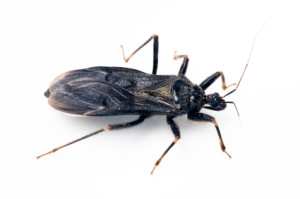 On the surface, a kissing bug sounds fun. Sadly, it doesn’t cause the world to smooch in perfect harmony. A kissing bug is just that: a bug. These bugs don’t cause property damage, but the bug’s bite and risk of transmitting Chagas disease render them worthy of strict pest control. Kissing bug sightings are currently on the rise in Central Texas.
On the surface, a kissing bug sounds fun. Sadly, it doesn’t cause the world to smooch in perfect harmony. A kissing bug is just that: a bug. These bugs don’t cause property damage, but the bug’s bite and risk of transmitting Chagas disease render them worthy of strict pest control. Kissing bug sightings are currently on the rise in Central Texas.
Kissing bugs, also called conenose bugs, assassin bugs and Mexican bed bugs, often lug around the Trypanosoma cruzi parasite and earned their primary name by biting around people’s mouths and eyes. If the kissing bug releases feces when it’s feeding, T. cruzi becomes absorbed into the kissing bug’s chosen buffet source; usually, humans and canines are unsuspecting buffet tables. During the first few weeks, a person infected with Chagas disease experiences swelling at site, fatigue, fever, a rash, constipation and abdominal pain. This is the acute phase, which becomes chronic if left untreated. Severe symptoms of the chronic phase include irregular heartbeat, inflamed or enlarged heart and sudden cardiac arrest, but these symptoms might not appear at all or might appear up to 20 years after the disease’s initial transmission.
Treatment during the acute phase focuses on killing the parasite, but no effective means of curing the disease exists after a patient reaches the chronic phase. Medical treatment in chronic Chagas disease consists of managing the symptoms as each appears in an individual. Aside from the kissing bug, Chagas disease can pass to a person through other means: an infected person can spread the disease through blood transfusion and organ transplant, pregnant women pass the disease to their babies, and with T. cruzi entering the body through consumption of contaminated food.
Considering the disease does result in fatalities of young children, the bug responsible for transmitting it bears a misleading name and surprisingly pretty markings. Kissing bugs have flattened, teardrop shaped bodies, and vary from brown to black. The body is outlined by a strip decorated with dots or stripes shaded from orange to red. The shape and coloring of this frame resembles a tiny snake around the body of the bug. It’s a distinct look. The bug’s cone-shaped head has segmented antenna and a noticeable beak.
If you see a kissing bug, it’s important that you disinfect the surface you’ve eyed the bug upon and not touch the bug with your bare hands. Since between 30 and 50% of kissing bugs in Central Texas have already tested positive for the T. cruzi parasite, and considering the severity of Chagas disease, you should have bugs found in your home tested for the parasite. The Texas A&M Research team will test collected bugs for you. Of course, if you live in Austin, contact us at ABC to discuss pest control measures. Let us take care of kissing bugs so you can take care of the important kissing of babies and such.